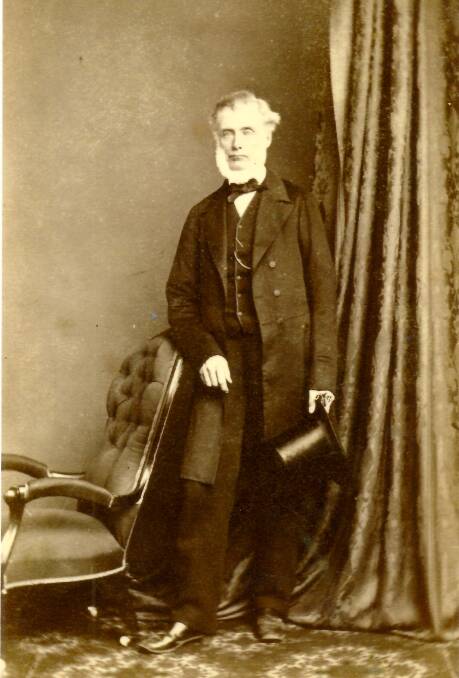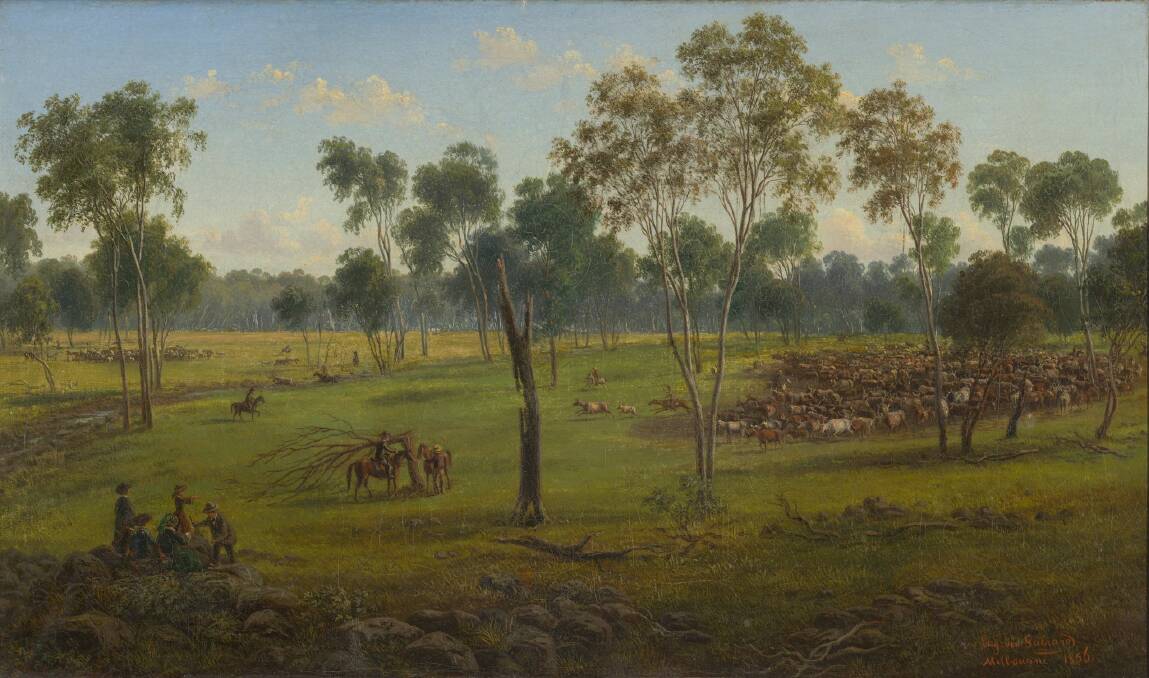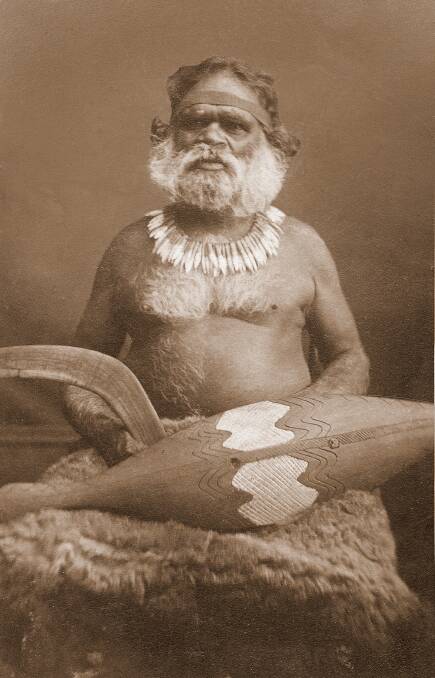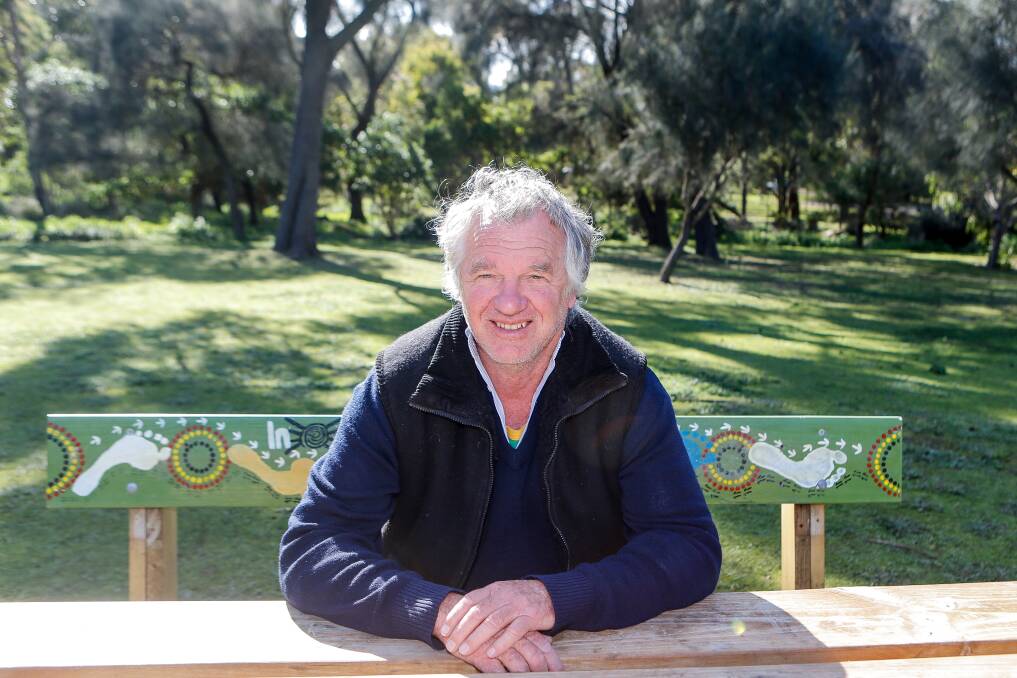
Eugene Von Guerard's painting Tower Hill is widely praised for its role in salvaging an ancient landscape but few know of the friendship between the two men frowned upon for having it done.
Subscribe now for unlimited access.
$0/
(min cost $0)
or signup to continue reading
The Standard's Jessica Greenan spoke with Camperdown farmer Nick Cole who recently featured in Rachel Griffiths' TV show Great Southern Landscapes to learn about his great, great, great grandfather James Dawson who commissioned the legacy painting.
Fortuitous meeting

Mr Dawson was an extraordinary man but he was also a bit of an oddball, Mr Cole says.
Born in 1806 in Bonnytoun, Scotland, he was the "first white man on the land" setting up a small farm near Hawkesdale before moving to Camperdown.
"He did some quite outstanding, extraordinary things, really - he was way ahead of his time and he was an outcast because of it," Mr Cole said.
"He was so different, he didn't do what anyone else did. He cared for the environment, he cared for the local Indigenous population when most others came here to make as much money as possible and go back to England to live a life of leisure.
"In 1850 he had a farm near Hawkesdale called Kangatong. At some point when travelling through the western district he saw the degradation going on at Tower Hill with the stripping of trees and the mining and farming of the area and he wasn't happy with it.
"There was no way of recording that degradation because they didn't really have photography at the time. It was in its infancy and they only really had paintings.
"I'm not sure how Von Guerard and James Dawson first made contact with each other, but it was one of those meetings which was fortuitous in that Dawson was keen on the environment and Von Guerard had the knowledge to paint it.
"I've seen a lot of other paintings where you can't really tell what's what - you see a tree, but you can't really tell what kind of tree it is. With Von Guerard's paintings, they're so architecturally correct that you can tell what species it is whether it's a catamaran, banksia, gum tree or eucalypt.
"He had such an incredible talent to paint like that it was clear he knew lots about the environment. So Dawson must've seen the degradation and he wasn't happy and wanted it recorded before it was gone. Getting a painter to do it was the cheapest and only way you were going to record it.
"What a lot of people don't know is Von Guerard didn't make a lot of money - he wasn't a very wealthy man. There were a lot of people painting in those days, they were sort of door-to-door salesmen. They moved around doing that sort of work, displaying their wares - he was just one of the better ones.
"Luckily he did do it though because without his painting, it might've been a very different outcome for today's icon."
Hidden messages

"From his paintings, we know Von Guerard knew this area very well and stayed here often," Mr Cole said.
"The two must have become very good friends. Von Guerard did another little painting which you can now find at the Benalla Art Gallery called Cattle Muster (Cutting Out the Cattle, Kangatong) in 1856, one year after Tower Hill.
"Von Guerard must've been staying with Dawson and his family at the property. In one of the corners, there are a few figures who we believe to be Jane Dawson, Joan Dawson and Isabelle having a barbecue with others which we think are Von Guerard's wife and daughter near a campfire."
Artistic advocacy

It wasn't the first time Von Guerard included figures in microscopic detail.
Mr Cole believes the depiction of Gunditjmara in the corner of Tower Hill may have been at Dawsons' request.
"Dawson wrote a book Australian Aboriginals and it's still regarded as one of the best documents you'll find on the local Aboriginal language and culture - it's quite an amazing book," he said.
"That's the sort of person he was, he was way ahead of his time. He was right out there, a lot of people didn't like him or think it was the right thing to do. He was well in front of where a lot of people put him.
"He was quite an amazing person in quite a lot of ways, he was one of the Aboriginal protectorates in the area, he defended and looked after them and there were plenty of times when he went to court for them and helped them out. He was fighting so they weren't just pushed aside.
"He buried Wombeetch Puyuun - Old Camperdown George as he was known locally - who was the last Djargurd Wurrung person to die in this area.
"He's buried under the monument in Camperdown in the cemetery on James' plot. He was going to have that re-stocked but he buried Wombeetch there and built the obelisk on top of it. Dawson's got a grave not far from it with Joan and Isabelle in it.
"James wrote the book, but Isabella his daughter spoke the language and we reckon she wrote the book with him but because in that era women weren't acknowledged, we reckon she didn't get the credit."
Missing pieces

Mr Cole says not much else survives from his ancestor's legacy.
"We don't have a lot of records - he had a museum in Camperdown near the theatre but it got burnt," he said.
"He had a huge collection, he did taxidermy, he did all sorts of extraordinary things but the whole thing went up in flames unfortunately.
"We know he bought a kit house with him when he first got here because he didn't know what to expect. He also bought duelling pistols because he didn't know what he was going into.
"He went from Melbourne up the Yarra and set up a dairy farm with someone else, that folded, he came out this way because he got married.
"His wife's cousin was in Lara so they came out this way and kept going up further to Hawkesdale and up to Kangatong.
"He went broke, he had rendering works in Port Fairy for a while, he seemed to have drifted around doing other things then made his way to Camperdown.
"There were other people like convicts around, you did have to have some money to do this because it took two years to get your money back from farming.
"You'd shear your sheep for example and put your wool on a boat to London. The cheque would take two years to arrive and if the ship didn't sink on the way then you'd get paid.
"There was a lot of gambling involved, but overall early farmers didn't make much money because everything crashed in 1841-42.
"The sheep and cattle they bought for a pound was probably worth a couple pennies, almost nothing. They didn't make a lot of money for the first few years because it all fell in the hole.
"We think Dawson probably benefited from the gold rushes in Ballarat though because most would've taken their stock to sell up there."
IN OTHER NEWS
- Comprehensive investigation into sacking of CEO continues two years on
- Regional buyers out-pace urbanites by a country mile
- Kristy Sellars finishes second in America's Got Talent
- Overtaking driver 'running out of road' clocked at 145km/h
- Hampden league grand final teams: Captain under injury cloud named
Our journalists work hard to provide local, up-to-date news to the community. This is how you can access our trusted content:
- Bookmark https://www.standard.net.au/
- Make sure you are signed up for our breaking and regular headlines and newsletters
- Follow us on Facebook, Twitter, Instagram and LinkedIn
- Tap here to open our Google News page.
- Join our Courts and Crime Facebook group and our dedicated Sport Facebook group
- Subscribe
Now just one tap with our new app: Digital subscribers now have the convenience of faster news, right at your fingertips with The Standard:

